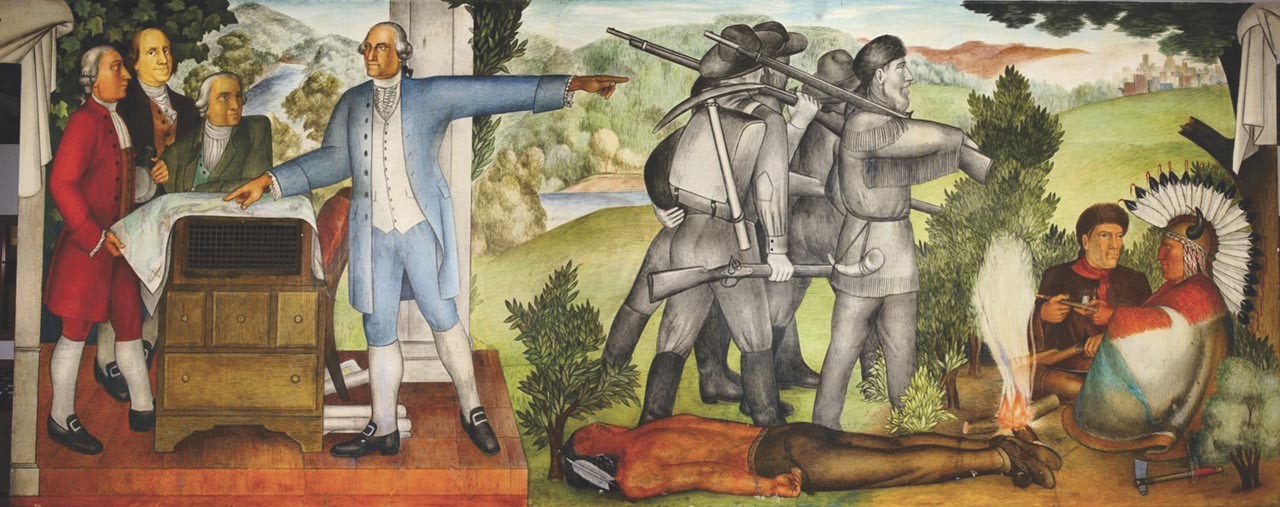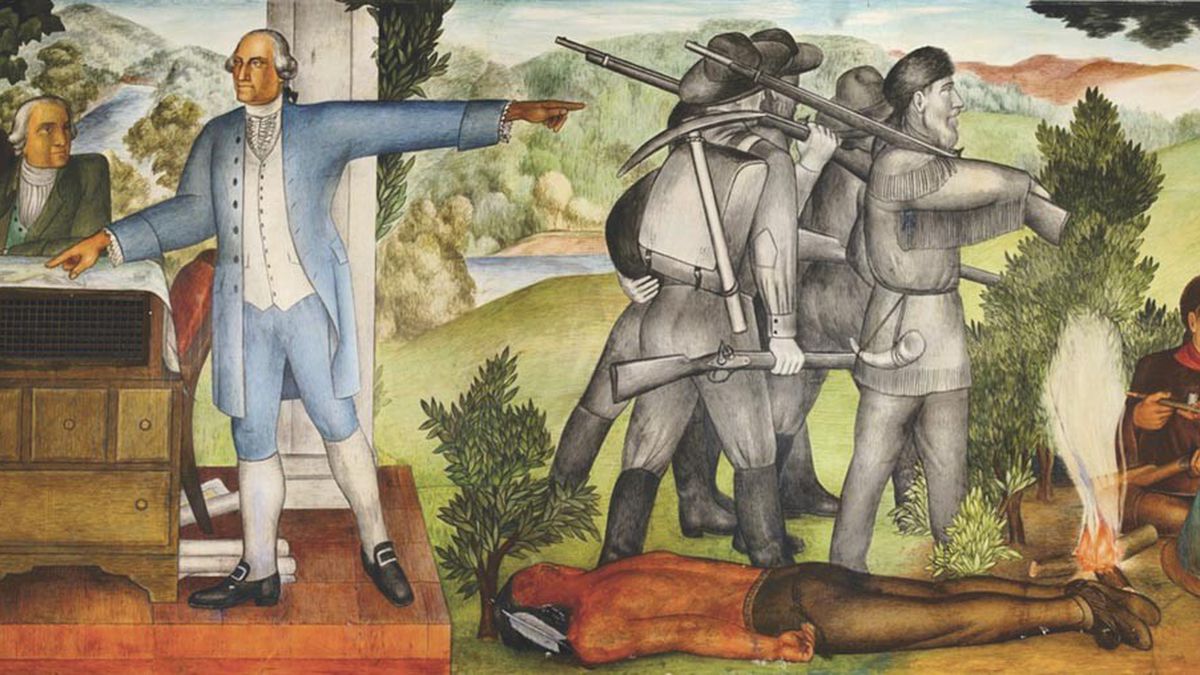
Our affairs are critical, and we must be dispassionate and wise. — POC Alexander Hamilton, getting better known these days.
If freedom of speech is taken away, then dumb and silent we may be led, like sheep to the slaughter. — George Washington, whitewashed blackguard.
The controversy over the 13-panel mural The Life of George Washington has called into question yet again the role of public art in culture and politics. Victor Arnautoff, a Russian-born muralist who worked with Diego Rivera in Mexico and supervised creation of the Coit Tower murals in San Francisco, was asked in 1934 to paint a mural for the city’s newly built George Washington High School. The 1600-square foot mural recently has come under attack for, to put it bluntly, political incorrectness — or a least insufficient political correctness for our enlightened, finicky times.
It’s unfair. Arnautoff, who was employed by the federal Works Progress Administration, said he carefully researched “this famous man, a committed defender of freedom.” But he also did not shrink from subtly depicting “the spirit of Washington’s time,” with its mistreatment of blacks and American Indians, abuses that customarily were glossed over by just about everyone 80 years ago.
Current thinking holds that Washington was a slaveholder and hypocrite, and thus no liberator; a champion of American expansion across North America; and that this tarnished history is too damaging to high-school students of color — and maybe sensitive white kids. Several passionately intense protesters — clad in black, naturally — at a July 15 panel discussion on the murals even raised placards and repeatedly shouted “Genocide!” Theirs was an intemperate position, ill-suited to a general noted for his air of command and self-control. Washington was described by one contemporary as “no harum-scarum, ranting, swearing fellow, but sober, steady, and calm.” Nor did their outburst befit an artist who harbored strong leftist convictions but — being more politically astute than we appear capable of today — also knew how far it was possible to go when, across the continent, Nelson Rockefeller ordered a Diego Rivera mural plastered over because of a portrait of Lenin that the artist adamantly refused to remove. Just the year before, Arnautoff had vainly counseled the prankish Coit Tower muralist Bernard Zakheim not to include a hammer and sickle in his mural, noting, “Freedom in America is understood in a special way.” Zakheim later conceded, “You were right, Mr. Arnautoff. I teased the bulls too much.”
Nevertheless, on June 28 the San Francisco School Board voted unanimously, on the nearly unanimous advice of a thirteen-person Reflection and Action Working Group (RAWG), to have the murals “painted down.”
“We come to these recommendations due to the continued historical and current trauma of Native Americans and African Americans with these depictions in the mural that glorifies slavery, genocide, colonization, manifest destiny, white supremacy, oppression, etc.,” the group reportedly wrote. “This mural doesn’t represent SFUSD values of social justice, diversity, united, student-centered. It’s not student-centered if it’s focused on the legacy of artists, rather than the experience of the students.”
The cost of this erasure is still unclear, but could exceed $600,000 to paint it over, mostly due to the expense of an environmental impact report. Covering the mural with panels would cost as much as $845,000, and curtains alone could cost up to $375,000. “It’s reparations,” concluded one of the board members, perhaps as dazzled by the astronomical cost of the solution as any GOP lobbyist similarly working for a better, freer world.
Those breathless condemnations and postmodernist-victim shopping lists, with their poor syntax and broadly inclusive, comical ‘etc.,’ constitute in no way a reparation. They constitute a sop to symbolic retribution. The punitive eradication of a liberal statement from the past is a colossal waste of money. (Can we impeach?)
Columnists ranging from the San Francisco Chronicle‘s art critic Charles Desmarais to art historian Brian T. Allen in the National Review —strange bedfellows — have weighed in for freedom of speech, the latter quite pointedly, outing by name all seven of the “anti-art fools” on the school board. Many of the school’s alumni and teachers along with hundreds of artists and educators oppose this censorship, counseling either leaving the murals intact and using them as educational tools (my position); or, if the anti-muralists insist on their pound of flesh, covering them (or the offending parts) with panels, at a much lower cost, and thus doing nothing irreversibly shameful, ignorant, and hypocritical, heaping national ignominy on the socialist shithole of San Francisco. Lope Yap. Jr., vice president of the GWHS alumni association and the sole RAWG dissenter, as well as a progressive filmmaker and person of color, has pledged to fight to save the murals. Lawsuits and injunctions are probably in the offing. Stay tuned.
I have opposed political censorship before, as in the teapot tempest over Dana Schutz’s Emmett Till painting, and I try to be independent from art-world groupthink. But L’Affaire Arnautoff contains so many delicious absurdities that slipping into my Henry Fonda Man-of-Reason costume became mandatory. There are three salient points to make about this imbroglio.
First, let’s dismiss the notion that art should be judged on its politics (what it says or enjoins) instead of its aesthetics (how it looks, makes us feel). This is the old style-versus-content conundrum, which always seems to suggest that we have to make a choice between saving the world and savoring it. We don’t. Art is often enlisted in the service of power, as all good postmodernist children know. Some of the best art ever made was commissioned to enhance the power and prestige of plutocrats and/or scoundrels — the Medici, the Hanoverians, the Bourbons, the cardinals and popes, the dynasties, etc. Nowadays we enjoy the splendor of that art while ignoring the imperial or imperialist unpleasantnesses that paid the artists. And we absolutely should revere the art, despite the complexities of history and patronage. If you look at the Sistine Chapel and see only the massacred Indians of the New World, blood transmogrified into aesthetic gold and silver, you deprive yourself of “the greatest thing that’s ever been done,” in de Kooning’s humorously worshipful words. But if you don’t know the sordid history behind the wealth, or ignore it, you’re not a morallly sentient adult. Michelangelo’s High Renaissance frescos, let it be noted, have survived even the Reformation addition of fig leaves by poor Daniele da Volterra, Il Braghettone, aka the Breeches-Maker.
Much other art sidesteps current affairs — like Abstract Expressionism, with its focus on pure expression (and its contempt for the leftist propagandist art of the 1930s: “poor art for poor people,” in Arshile Gorky’s memorably dismissive aphorism). None other than the U.S. government later promoted its cult of the heroic individual, easily co-opted to serve as propaganda for American-Way capitalism and consumerism. Rampant individualism vs. creeping collectivism worked in the Cold War; expect a reprise (not a reprieve) again in 2020, bigly. Some artists manage to bestride both worlds: During the Vietnam-era 1960s and 1970s, Philip Guston abandoned the elegant shimmering abstractions he made in the 1950s, loosely based on Monet, in order to revisit the dark Klansman social commentary that he made in the 1930s. His stylistic epiphany and conversion from heavenly formalism — “adjusting a red to a blue,” as he later put it, wryly, to sinister and comic narratives like his excoriating drawings of scowling, scrotal Tricky Dick — evoked passionate reactions in the art congregation; he was assailed as a traitor by some, and as a visionary by others. Politically engaged art and fine art are both valid; and both produce good and bad art: propaganda on the one hand, decoration on the other.
As to actual treason, remember that in the late 1940s, before Life magazine discovered Pollock the Cowboy, Abstract Expressionism was seen not as red-blooded he-man stuff, but as the decadent, effete art of communists, eggheads, and other bearded, bereted subversives, who might be hiding military secrets in those blobs and squiggles. The McCarthyite Republican senator from Michigan, George Dondero, deserves exhumation:
“Cubism aims to destroy by designed disorder. … Dadaism aims to destroy by ridicule. … Abstractionism aims to destroy by the creation of brainstorms.” In 1952, Dondero went on to tell Congress that modern art was, in fact, a conspiracy by Moscow to spread communism in the United States. This speech won him the International Fine Arts Council’s Gold Medal of Honor for “dedicated service to American Art.” When art critic Emily Genauer (future winner of the Pulitzer Prize for Criticism) interviewed Dondero in the mid-1950s, he stated “modern art is Communistic because it is distorted and ugly, because it does not glorify our beautiful country, our cheerful and smiling people, our material progress. Art which does not glorify our beautiful country in plain simple terms that everyone can understand breeds dissatisfaction. It is therefore opposed to our government and those who promote it are our enemies.” When Genauer pointed out the resemblance between his views and those of the Stalinist Communists he despised, Dondero was so enraged that he reportedly arranged to have her fired from her job at the New York Herald Tribune.
Second, The Life of George Washington is an excellent subject for education about art, culture, and politics. While some see Arnautoff’s mural as a counter-myth or corrective to the semi-divine man-of-all-seasons status accorded our first president for two and a half centuries, I see it as a calculated correction by an artist who had learned to be discreet and modulated. Arnautoff was persona non grata in the USSR for decades because of his having fought against the communists during the Russian Civil War. Conversely, after his conversion to communism in the 1930s, during the San Francisco General Strike, he was investigated by the FBI for his links with Russia and his associations with visiting cultural figures and artists like Diego Rivera and other communist intellectuals in early 1930s Mexico City. Arnautoff’s biographer, Robert W. Cherny, repeatedly emphasized during his hotly disrupted July 15 presentation that Arnautoff’s murals were in no way disrespectful to blacks and American Indians.
Of the Washington mural, Cherny wrote that even as the popular portrayal of California Indians still depicted them as primitive and degraded, “Arnautoff treated them with dignity, presenting the complex artistry of a woman’s basketry and the man’s fox-skin quiver. He also depicted the meeting of Indians and Spanish authorities as a meeting of equals, a sharp contrast to the depiction of that event in the city’s “Pioneer Monument” (1894), which shows an Indian groveling at the feet of a ranchero and priest.” That monument was removed from Civic Center by the City of San Francisco in September of last year, and deservedly so.
“Arnautoff said nothing, then or later, about his murals’ counter-narrative to that then-standard high school treatment of the founding fathers and Western expansion,” Cherny wrote. “Washington dominates five of the six smaller murals but the centers of the four largest barrels are held by native Americans, working-class revolutionaries, and enslaved African Americans. In depicting Washington’s early life, Arnautoff centered the mural on native Americans in war paint, surrounded by British, colonial, and French troops and British colonists. In the facing mural, on the American Revolution, the center belongs to five men in working-class clothing raising the flagpole. VA’s portrayal of Mount Vernon puts Washington near the left margin and places enslaved African Americans at the center, more prominent than several white artisans on the right side of the mural. … Arnautoff’s’s mural makes clear that slave labor provided the plantations’ economic basis. On the facing wall Arnautoff was even more direct: the procession of spectral future pioneers moves west over the body of a dead Indian, challenging the prevailing narrative that westward expansion had been into largely vacant territory waiting for white pioneers to develop its full potential. For Arnautoff, ‘the spirit of Washington’s time’ included not only the struggle for liberty and the founding of a new nation but also chattel slavery and the slaughter of Native Americans.”
Arnautoff’s murals are indictments of America’s failings. They are not as dramatic or tragic as the Mexico City and Cuernavaca murals that Arnautoff helped Diego Rivera paint, full of armored, mounted conquistadores battling hand-to-hand with jaguar-costumed Aztecs wielding obsidian knives, or tortured, lashed Indians at the missions. Thus, they are more ambiguous in their sympathies to the casual viewer. They are on the side of the oppressed, however, while simultaneously giving Washington his due without sanctimoniously demonizing him for being of his time, not ours.
Thirdly and finally, the notion that adolescents are excessively delicate and need protection from reality and history is deeply repugnant and patronizing. Even the most temperate of the anti-muralists seems to assume that Americans are not able to handle the inconvenient truth that people do bad things to other people in the names of God, justice, empire, or mere self-interest. Arnautoff’s stately mural, even with its hints of America’s dirty hands, is no rival for the breathless farrago of mass shootings and abusive drivel that bombards us 24/7.
Remember H.G. Wells’ bestial Morlocks and elfin Eloi from his novel The Time Machine? Given the challenges that we face today, we cannot afford a younger generation trained to accept virtuous passivity. We need revolutionaries with smarts and moxie, and considerable skill at critical thinking — not just in being unthinkingly critical as instructed at the latest Two Minutes Hate. 














